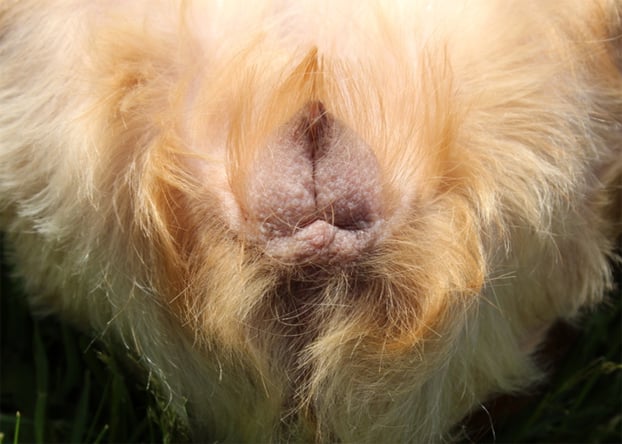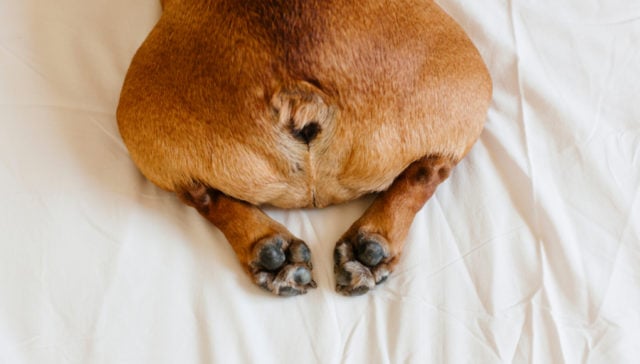
Table of Contents
If you're looking for dog vulvar dermatitis home remedies, chances are you're now getting pretty worried about the redness and swelling appearance of your female dog's nether area.
Popularly called dog vaginitis, this condition is common among female canines that show inflammation or infection in their vagina.
But fret not; there are many easy dog vulvar dermatitis home remedies you can do at home! (More on that in a bit.)
As you move further, this article will also tackle the following important topics:
- What this illness is all about
- Causes and symptoms of dog vulvar dermatitis
- Types of vaginitis in dogs
- Other treatments you can consider
- When to see your vet
- Dog vulvar dermatitis FAQs
So if you come across this condition in your dogs, it's best to equip yourself with the whats, the whys, and the hows to treat it.
Let's get right into it, shall we?
7 Easy Dog Vulvar Dermatitis Home Remedies
When you can't see a vet just yet and if you're seeing the first signs of infections, then you can give these options a try:
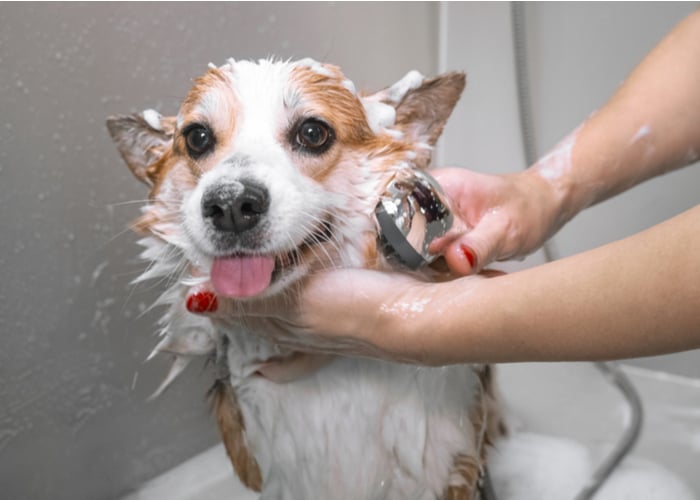
1. Give Them a Good Bath
One of the causes of vaginitis in dogs is bacteria buildup.
The best and most straightforward way to avoid it is to give your pooch a good bath.
If it's a yeast infection, it's easier to remove any wax buildup or any thick crust sticking in your dog's rear.
Tip: The most recommended ingredient for your shampoo is benzoyl peroxide.
2. Apply Apple Cider Vinegar to their Skin
To make sure you have killed any bacteria left, you can finish it off with apple cider vinegar.
You can mix it with a good amount of water and spray it on the affected areas.
Meanwhile, white vinegar works just the same.
But what makes apple cider vinegar a great option?
It contains healing properties — something that regular vinegar doesn't have.
3. Keep the Living Area Clean and Dry
Yeast and bacteria thrive in moist and dirty environments.
That said, one of the most basic dog vulvar dermatitis home remedies you can do is to keep your living area clean at all times.
When you keep your surroundings tidy and dry, there are fewer chances that your pooch could develop infections.
Tip: Clean the spot where your dog spends most of its time.
This could be their crate, the couch, or their doggy bed.
You may also want to change sheets more frequently.
4. Clean Their Bum with Unscented Wipes
If your puppy has dog vaginitis, you will see a discharge with an unusual color.
You can easily wipe it off with unscented or antiseptic wipes.
However, keep in mind that home remedies for adult dogs with vulvar dermatitis require veterinary intervention.
Unlike puppies, wiping or washing that area of an adult female dog can alter its pH level.
5. Treat the Affected Areas with Coconut Oil
Coconut oil not only soothes the pain in your dog's skin.
But it also helps brush off any wax buildup in their rear. Plus, coconut oil is something you can easily find in local stores.
When you use coconut oil, you can roll your dog over and apply it to the affected areas.
Alternatively, you can also try CBD oil.
Among its many potentials are its anti-inflammatory and soothing properties that can make it helpful in treating vulvar dermatitis in dogs.
RELATED: Do Vets Recommend CBD Oil for Dogs?
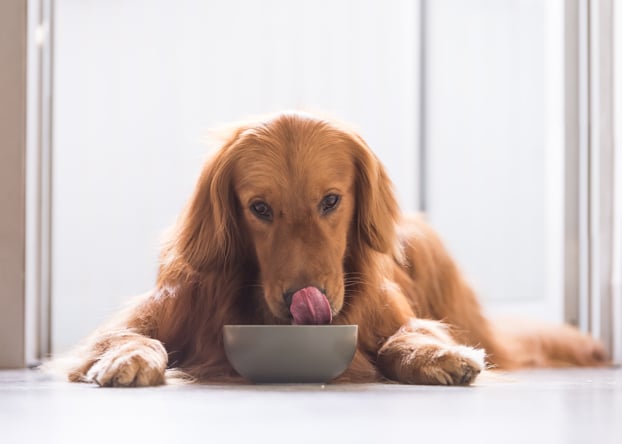
6. Change Your Dog's Diet
Inflammation in the dog's vulva could be affected by their diet, allergies, and food sensitivities.
Hence, make sure your dog eats quality dog food rich in protein.
Also, avoid dog food with any fillers or additives.
Tip: You can opt for supplements with omega-3 fatty acids to reduce skin inflammation or allergies.
When you're in doubt about your puppy's diet, you can consult your vet about it.
Or you can try our vet-approved homemade puppy food recipes, too.
7. Add Probiotics to Dog's Meals
You can give your dogs a dose of probiotics to balance their gut bacteria and maintain the pH at a healthy level.
This also helps prevent dog vaginitis from occurring.
Note: Another thing you should keep in mind is whether your dog is sensitive to dairy or not.
If your dogs are, then it's best to give them non-dairy probiotics.
But if you're uncomfortable giving any form of probiotic to your pooch, you can opt for the natural alternative: olive leaf.
It has oleuropein that helps boost the immune system and fight pathogens.
Other Dog Vulvar Dermatitis Treatments You Can Try
Home remedies are ideal if the condition is mild or occurs in female dogs before puberty or on their first heat.
But if they aren't doing much to ease your dog's symptoms, the vet may prescribe the following treatments.
Make sure to talk to a vet first before administering these yourself!
So, here's a list of other dog vulvar dermatitis treatments that you can give to your puppy:
Topical Medication
You may want to put some ointment on affected areas to relieve pain, discomfort, or itch.
Remember: Make sure to use topical medications that are suitable for dogs.
Don't use any human ointment or over-the-counter options that your vet doesn't recommend.
Otherwise, this might add up to the problem.
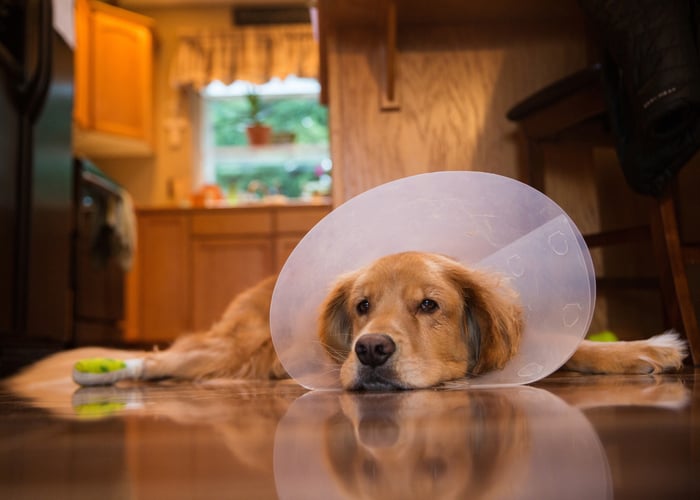
Elizabethan Collar
Nobody likes putting “the cone of shame” on their pup. But if it helps with the healing process, then it's worth a try.
Although it doesn't directly help with dog vaginitis, putting this cone prevents your dog from licking the affected areas.
This works best when you're putting cream on the rear end, allowing the infection to heal quickly.
Antibiotics
If the cause of dog vaginitis is a bacterial infection, your vet will administer antibiotics to your dogs.
This applies to much older pooches with worse, persistent cases.
Other medical prescriptions include anti-inflammatories, hormone therapy, or glucocorticoids.
Spaying
If vaginitis in dogs is chronic, topical medications and home remedies may no longer be effective.
However, spaying can be a beneficial procedure for older female dogs, which involves removing the uterus and ovaries.
Also Read: 14 Benefits of Spaying and Neutering Your Dogs
Surgery
As one of the last options for dog vulvar dermatitis treatments, surgeries can be done depending on the cause.
If there's an anatomical anomaly or a foreign body in the vagina, surgery is the best treatment.
This may be a risky, invasive procedure for your pooch, but it saves them from the chronic pain of dog vaginitis in the long run.
Overview of Dog Vulvar Dermatitis
Dog vulvar dermatitis, a.k.a. dog vaginitis, refers to the infection of the skin folds around the vulva where urine and secretions can build up.
There are several reasons why this happens. According to the American College of Veterinary Surgeons:
This can be due to obesity, breed conformation, or due to early neutering (juvenile vulva).
– ACVS
Furthermore, yeast and bacteria can thrive in your dog's rear end, thus, causing inflammation in your furry buddies.
This condition can occur in both puppies and older female dogs.
Vaginal infections have many signs to look out for, but a common symptom is your dog's vagina getting swollen.
When this happens, you may observe the condition for a day or two.
However, it's best to check with your vet for a proper evaluation.
Causes and Symptoms of Dog Vaginitis
Dog vulvar dermatitis could be inevitable when you have a female pet dog.
To help you be on the lookout, here are a few common causes of vaginitis in dogs:
- Trauma
- Ectopic ureter (anatomical defect where the urine duct isn't attached to the bladder)
- Yeast infection
- Vaginal abscess or boil
- Bacterial infection
- Stuck foreign bodies
- Irritation from excess urine or feces
Meanwhile, look out for these symptoms in your female dogs if you think this is the case:
- Swollen vagina
- Discomfort or pain
- Bum or rear-end scooting
- Frequent or difficulty urinating
- Reddish skin around the vulva
- Excessive licking in the rear end
- Vaginal discharge (blood or unusual color)
- Increase in the urge of male dogs to mate with your female pooch
As a dedicated pet guardian, knowing the cause and symptoms will help you determine the most suitable dog vulvar dermatitis treatment.
Interesting Read: 5 Embarrassing Dog Health Concerns
Types of Vulvar Dermatitis in Dogs
Dog vulvar dermatitis is classified into two types, where age is a contributing factor.
So, take note of your dog's age to assess which type of vaginitis it has.
Juvenile Canine Vaginitis
This type of dog vulvar dermatitis is commonly known as puppy vaginitis.
It occurs in canines from 6-18 months of age with the following causes:
- An inverted vulva
- Fecal contamination
- Urinary tract infection
This condition accompanies vulva swelling or unusual discharges.
Fortunately, there are easy home treatments for puppy vaginitis which we'll tackle below.
Adult Dog Vaginitis
Also called adult-onset canine vaginitis, this condition is more common among spayed female dogs than intact ones.
Unlike dog vaginitis in puppies, this type is more complicated and could be a serious, underlying health issue.
If your adult female dog has vaginitis, you will see similar symptoms, just like in puppies.
But treating them at home may not be enough. In this case, you'll need to seek veterinary care immediately.
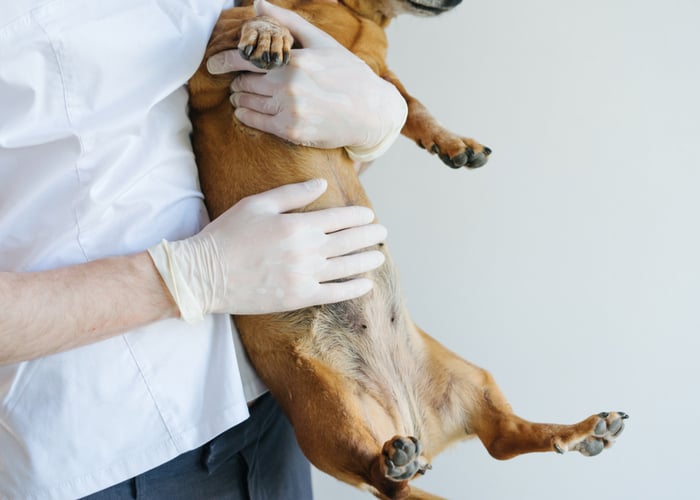
When to See Your Vet
In cases when dog vulvar dermatitis home remedies don't seem to work, then head to your vet immediately.
That's because this condition is a bit tricky to identify.
So, a series of tests must be done to diagnose canine vaginitis properly, including an assessment of your dog's medical history.
In other cases, the vet may express the anal glands and assess for signs of tumors, excess skin, or other abnormalities.
How to Prevent Vaginitis in Dogs
Vulvar Dermatitis can happen in young or adult pups.
While it's most common in puppies (a.k.a. juvenile vaginitis), it's still best to practice good hygiene to make sure that it's not something out of the ordinary.
Here are some steps you can take to help prevent vaginitis in dogs:
1. Practice good hygiene: Keep your dog's genital area clean and dry, and avoid using harsh soaps or chemicals that can irritate the area.
2. Avoid irritants: Avoid exposing your dog to irritants such as chemicals, perfumes, or other products that can cause inflammation or infection.
3. Keep your dog's immune system healthy: A strong immune system can help prevent infections and inflammation. Make sure your dog is getting a balanced diet, regular exercise, and appropriate veterinary care.
4. Spay your dog: Spaying your dog can help reduce the risk of vaginitis, as it eliminates the hormonal changes that can contribute to the condition.
5. Monitor your dog's behavior: Watch for signs of vaginitis, such as licking or scratching at the genital area, discharge, or a foul odor. If you notice any of these symptoms, contact your veterinarian for evaluation and treatment.
By taking these steps, you can help prevent vaginitis in your dog and keep them healthy and comfortable.
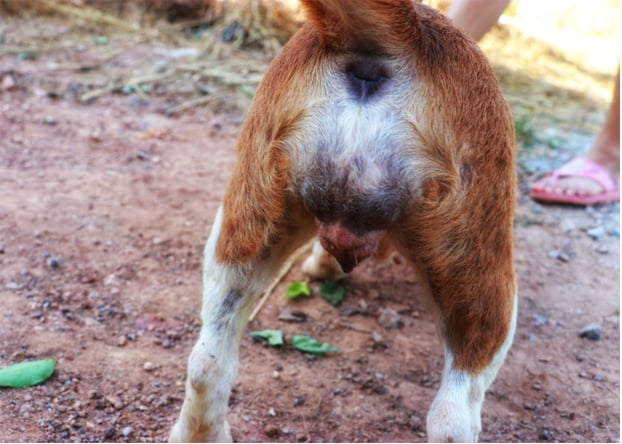
Common Questions About Dog Vulvar Dermatitis
Check out this list of frequently asked questions from dog owners alike:
Can I Apply Hydrogen Peroxide to My Dog's Vagina?
If you see that the dog's vag is swollen or bleeding, you can clean it up with warm water and a cotton ball. Refrain from using hydrogen peroxide.
You might be tempted to use over-the-counter medication, especially if the dog's vagina appears dirty or bleeding.
However, some human ointments don't work or are dangerous to dogs.
What are the Other Terms for Dog Vulvar Dermatitis?
Dog vulvar dermatitis is often referred to as dog vaginitis. They mean the same and can be used interchangeably.
In other cases, this condition is confused with dog vulva yeast infection.
They can be related, but the two are different things. However, yeast infection could result in dog vaginitis in the long run.
That's why it's important to have dog vulvar dermatitis diagnosed by an expert since the symptoms are very similar.
Can I Put Vaseline as an Ointment?
It's not advisable to use over-the-counter or human creams for your dog. However, Vaseline is an exemption.
You just have to make sure that it's fragrance and paraben-free.
Other exemptions include A&D and zinc oxide ointment.
Apply a small amount of these canine creams into your dog's vulva to protect the skin and ease the discomfort. You can use olive or vegetable oil if you want a natural alternative.
Does Vulvar Dermatitis Go Away on its Own?
Dog vaginitis is common among prepubescent female dogs about to have their first heat cycle. So, you shouldn't worry too much if your teenage pooch has dog vulvar dermatitis.
Once the heat cycle is over, vulvar dermatitis tends to go away on its own.
But in cases that it doesn't, it's best to check with your vet on what caused vaginitis in the first place.
Dog Vulvar Dermatitis Home Remedies: Before You Go…
There are many dog vulvar dermatitis home remedies you can choose from if you find your dog has this condition.
Don't worry; it's pretty common among female dogs, regardless of their age. But it would still help if you practice good hygiene and some other ways to prevent it.
Also, it's always best to seek your vet's help, especially in severe cases of infection.
Chances are, a simple swelling could mean a serious underlying condition, such as tumors. This will involve more invasive treatments like surgeries.
Did you notice something similar to your female pup's area? What did you do to treat it? Share with us your experience!
You can also read a couple more interesting articles linked below related to a dog's genital health.


